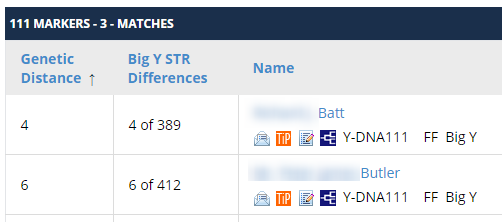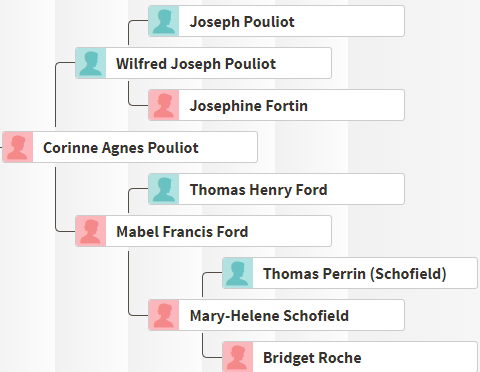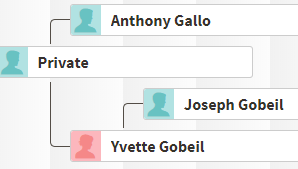My wife’s brother recently took a YDNA test. I can’t do an AncestryDNA Shared Clustering for my wife’s father because he didn’t test at AncestryDNA, but I can look at Aunt Suzy’s Shared Clustering
What Is Shared Clustering?
Shared Clustering is looking at shared DNA matches. The theory if you have a bunch of shared matches that also match each other they are likely from a common ancestor. Jim Bartlett got the idea of walking back your shared clusters. That means starting with your more recent clusters and going back through the years to check on and verify your older clusters which represent more distant ancestors. Jim used Jonathan Brecher’s Shared Clustering Program.
Let’s Download Aunt Suzy
I used Jonathan Brecher’s program to download Aunt Suzy’s AncestryDNA results:

Aunt Suzy also goes by Virginia which is probably a more official name. Suzy has over 68,000 total DNA matches. That should take a couple of hours to download. Once the download is down I’ll be able to look at Suzy’s clusters.
What I Expect Based on Suzy’s Ancestry
I already know what to expect in general from this excercise. Half of Suzy’s ancesty is French Canadian. They will result in many matches. The other half is Irish and they will result in fewer matches and shared ancestors.

Suzy’s dad was from an Irish background. Suzy’s mom was more recently from French Canada.
A Test Run of Shared Clustering
Suzy has 82 third cousins. Where do I set my first cluster level? Ancestry says that Suzy should start getting third cousins at 199 cM. However, I clicked through a lot of Suzy’s actual cousins and the third cousins didn’t show up until somewhere bettween 128 and 118 cM. So I’ll set the first cutoff at 123 cM. Odd number:

This was good enough to give me a paternal and maternal view of Suzy’s ancestry:

Cluster 1 is paternal and Cluster 2 is maternal. The thing that looks like a Red Cross plus sign in the middle would be Suzy’s closer relates. They match on her father’s and mother’s sides.
I’m going to put Suzy’s cluster results in a chart sorting her clusters by grandparent:

Spoiler alert is that Suzy should have a lot of LeFevre matches. I could put in Suzy’s paternal and maternal single clusters in the chart, but that would be a waste of space. Instead, I’ll bring Suzy’s cluster level down to a maximum of 50 cM from 123 cM:

Still there are only three numbered clusters, though, as above, I can see clusters within the clusters. I’ll go lower still.
At a 40 cM Limit, Suzy Has 8 Clusters
I’ll be happy to start here:

Things get a bit blurry at this level. There are 216 matches on this chart. They are not all in clusters, but most of them are.
Cluster 1
This should be easy:

Here as a Common Ancestor, Joseph Pouliot is listed as well as Pepin. However, this relationship goes back several generations:

Maybe not so easy. The Pouliot that I was thinking of is in Cluster 5:

Three of the matches have the common ancestor of Joseph Pouliot and Josephine Fortin:

I’ve been in touch with Fred. Because there are two common ancestors, I don’t know which one the DNA goes with, so for now I choose the daughter in Virginia’s line who is Emma Pouliot:

On to Cluster 2
I put Cluster 1 on hold. Cluster 2 is quite large:

In order to tame it, I retrieved all the common ancestors from Cluster 2 and put them in alphabetical order:

This name comes up quite often:

However, this goes quite a ways back. I think I need a new set of clusters. I’ll go back up to 45 cM to see if this makes things simpler:
5 Clusters for Suzy at 45 cM

The thought is, that if these clusters are obvious, they should map to the 40 cM clusters.
Cluster 1 Is Large

By the common ancestor names, this must be a LeFevre cluster. Here is a popular common ancestor:


One step backward, two steps forward?
Cluster 2
This should be the same Cluster that Fred was in above:


Cluster 3 Goes To Old Common Ancestors
This was the problem I was having with Cluster 1 at 40 cM. In fact, I’ll go to Access to compare the 40 cM clusters with the 45 cM Clusters:

I start with the 40 cM clusters as there are more with them. I join them to the 45 cM clusters by the Test ID. Then for the join I choose option 2. That says include all the records from Virginia’s 40 cM cluster and only those records from Virginia’s 45 cM Clusters where the joined fields are equal. Then on the part below in the query screen, I reverse the order with the 45 cM results first, so it will look more like my summary table.
It is possible to do this without Access but it would take quite a bit of time. I also group my query results. This takes out the duplicates:

This shows that the Cluster 3 I was looking at with the 45 cM cutoff, maps to Cluster 2 at 40 cM. Cluster 2 at 40 was the same one I looked at above and was having trouble with because the common ancestors were so ancient. I then took the clusters up to 47 cM:

This shows Clusters 4 and 5 at 47 cM. Cluster 4 is the more recent Pouliot Cluster. That tells me that there are a lot of connections between the two Clusters and that the bigger cluster must be an ancestor of Pouliot (or Fortin).
Here are the same two corresponding clusters at th 45 cM cutoff:

Now they are Clusters 2 and 3. As the larger cluster is an ancestor of Pouliot, I’ll extend Emma Pouliot’s tree:

This brings Suzy out to her 5th cousin level. However, some of the common ancestors were out at the 6th cousin level. The confusion could be that there are two Trembely or Tremblay lines. However, both Tremblay lines go through Josephine Fortin. Here is her line with the Cluster 3 common ancestors highlighted. Actually, these are the Cluster 2 Common ancestors from the 40 cM run:

All these common ancestors funnel down through Emma Fortin. Imagine that you are John Brecher’s computer program and you had all of these ancestors. What would you do? You would probably come up with something like Cluster 3.
Bottom line:

Here I mapped Cluster3 at 45 cM to Cluster 2 at 40 cM. It’s a lot of work to map one Cluster, but I feel as though I got it right.
Cluster 4 at the 45 cM Cutoff

Cluster 4 is off to the bottom left of Cluster 3. Cluster 4 has some affinity with Cluster 3 as can be seen by some of the matches to the left of Cluster 4 and underneath Cluster 3. Cluster 4 at 45 cM maps to Cluster 1 at 40 cM. This is one that I got stuck on above.
I’ll take what I learned with Cluster 3 and apply it to Cluster 4. I’ll just say that this Cluster goes to Joseph Pouliot born 1848:

Above I highlighted the AncestryDNA suggested Common Ancestors for Cluster 4.
Cluster 5 – The First Irish Cluster
So far, I have been dealing with French Canadian clusters. This is the first Irish one.

This Cluster has both of Suzy’s Irish grandparents, so I’d rather not put it in my spreadsheet just now. In general Butler is at the top left and Kerivan is the rest of the Cluster. I note that, based on my previous Access query, this will be mapping to two Clusters at 40 cM.
Back to the 40 cM Clusters
Irish Cluster 5 at 45 cM mapped to Clusters 6 and 7 at 40 cM. I’ll start with those.

In addition, there are now Clusters 8 and 9. Due to close relatives, Cluster 6 has Butler and Kerivan still. Here is the area with just Butler:

I’ll call that 6a.
Clusters 6b and 7
Here are Clusters 6b and 7:

However, both Clusters have the same two common ancestors. It could be that one Cluster favors Kerivan and the other Rooney. I would rather assign them both to the daughter at this point.
Clusters 8 and 9
Clusters 8 and 9 are small. They seem to favor the Kerivan side. One person in Cluster 8 has a tree with 247 people:

I notice he has a Bridget Rooney in his tree. At this point, I could try to build out his tree or wait to see what happens with further clustering. I’ll create a tree as I’m curious. I’m having trouble getting back to Bridget from Alice McCusker. Here is a transcription of her baptismal record:

One of the witnesses was a Patrick Rooney.
It looks like the family was enumerated as McCarty in 1870:

In 1880, Bridget was a widow:

This record pulls things together:

From that record, I get this:

Lawrence and Suzy are third cousins.
I don’t like the look of Cluster 9, so I’ll ignore it for now:

When I say I don’t like the look of it that is because it appears that this could be two small clusters.
Clusters 3 and 4
In my mapping, the previous Cluster 1 went to Cluster 4, so that is LeFevre. Here are the listed Common Ancestors for Cluster 4:

The Butler entries are too close for clustering. Most of the Common ancestors seem to go back to Lazare Lefevre and Adelaide Boure:

However, one went back to Methot and Anger:
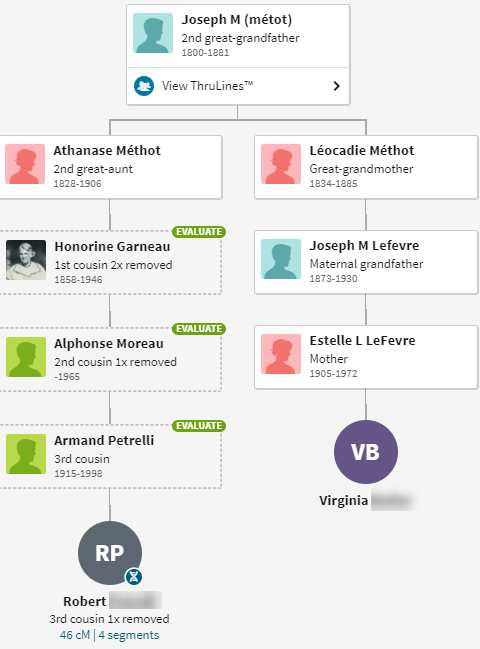
Ancestry would like me to evaluate this tree. I’ll bite.
I am questioning why Armand Petrelli is the son of Alphonse Moreau. The 1930 Southbridge Census has Armand as the son of Joseph Petrelli:

Actually, I see what happened.
Robert got his tree backwards:

His mother is Moreau. His maternal grandfather should be Alphonse Moreau – ot Joseph Petrelli.
Here is Jeanette in 1920:

The other problem is the Athanase I have in my tree is a man and Robert’s connection to me is shown through a female Athanase.
I think I’ll just assume that this is an earlier LeFevre Cluster rather than Methot:

That leaves the new Cluster 3:

Cluster 3 has four connections to Cluster 2 (Fortin) and two to 4 (LeFevre). I don’t have a lot of information, so I’ll just add Cluster 3 near Fortin:

This could be a long Blog, but I like that the clusters seem to be falling into place – even with the French Canadian families.
Suzy’s 18 Clusters at 35 cM
This looks like the 1,000 foot view:

In Access here is how the previous clusters map to this set of clusters:

This is interesting because the Cluster 3 I was looking at above, maps to 7 and 8 but Cluster 2 also maps to Cluster 7.

Cluster6 mapped to 9, but I had a 6a and 6b. It turns out that the Cluster 9 has not separated out yet due to Suzy’s close relatives being in that cluster. From above, it looks like a lot of the action is in the French Canadian quarters.
Looking At the Irish Side – Down to 30 cM
I’ve decided to take a new easier approach. I am more interested in the Irish side at this point. The French Canadian side is interesting, but much of the genealogy is seemingly well-defined. At least the answers seem to be there if you dig deep enough. Describing the French Canadian clusters may be interesting, but it is a lot of work. I had some luck above with Rooney, so I’ll stick with the Irish and go down another level to 30 cM.
I ran the Shared Clustering program and came up with some more large French Canadian Clusters. I notice there is a button where you can filter out the larger clusters.

I thought I wanted to use the first box, but that is for the entire file. I want the second box to get rid of the large French Canadian clusters. Without this filter I get:
- Cluster 2 goes from row 15-266
- 21 goes from 441 to 485
- 22 which I want goes from 487 to 509 or about 23 rows
I’ll try setting the cutoff at 40 members. I like this because I can now see what is going on:

This reduces the number of clusters and changes the cluster numbers, but that is OK. I’ll just put another heading on my Summary Chart:

I brought these new restricted clusters into Access and compared them:

Here I have only 5 clusters. That made a huge difference. Without the 40 member cutoff, I get 31 clusters. Life just got simpler.
Above Cluster 9 goes to Clusters 1 and 2. Cluster 9 was the one that I had split previously. Here are the new Clusters 1 and 2:

Cluster 1 is the Kerivan side and Cluster 2 is the Butler side.

This is interesting because former Clusters 10 and 11 reclustered into the new Cluster 1. Now I’m curious to see how the unfiltered Clusters would have mapped:

This goes off the page above. One unexpected result is that under this configuration the previous Cluster 9 now only maps to one Cluster 4. However, now the old Clusters 10 and 11 map to their own clusters. With the restriction of the large clusters, I was expecting no effect on the Irish clusters, only on the large French Canadian clusters. However, the restriction also had an effect on the Irish Clusters.
The bottom line is that I could work with either the restricted or non-restricted clusters, however, for the purpose of looking at the Irish clusters, I would rather deal with the restricted clusters.
Irish Cluster 1
At 30 cM with a restiction 40 per cluster, I get two Irish Clusters. The first one is the Kerivan side. The first person on the list is not in the cluster but has matches to Cluster 1. He has a small tree with a Hanrahan in it. The fourth on the list shows a correclation to Cluster 1 and has a public tree. I don’t see any obvious match and would prefer not to build out this tree.
The last person before the Kerivan Cluster 1 has a curious common ancestor named Mary:

This looks worth pursuing. The relationship is shown as half first cousin, but it is likely a full cousin relationship unless Mary married two different Rooney’s. Here is Suzy’s tree starting with her Kerivan grandfather:

The Ancestry shared ancestry tree looks suspicious also because it appears to show that there were two brothers named Timothy Rooney. I’ll try to recreate Daniel’s tree to see what is going on. I was having trouble with the tree, then I found a chart I had made a while ago:

This shows John Henry descending from a first wife of Timothy Rooney. I’ll put that on my new Rooney Tree:

I’ve ended up with a half relationship after all. However, it now appears that Daniel and Suzy are 1/2 third cousins once removed. I tried to distinguish the two branches with different colors.
The next person in Cluster 1 who I haven’t looked at yet is FG:

FG has an unlinked tree:

I noticed the name McCusker:

I like the easy ones. See, I’m a Rooney specialist.
Andrew from Cluster 1
The next person in Cluster 1 with a usable tree is Andrew:

After a little snooping around Ancestry, I came up with this:

Andrew goes on my Rooney Tree:

That brings up a point. The first three matches are not Kerivan matches. Technically, that makes Cluster 1 a Rooney Cluster.
Russell and Sandra
Russell and Sandra should be easy as they show Common Ancestors at Ancestry:


Bob’s Tree Looks Hopeful
Bob, who is in Cluster 1, has this tree:

Here is a quick tree to get him on my Chart:


Donna and John
I have a note that Donna is the mother of John and that I wrote a Blog about John. Here is John at Ancestry:

It looks like a good time to start a separate Kerivan Tree:

I found Donna’s sister in the mix also.
H6 and a More Challenging Tree?
H6 is in Cluster 1 with a match of 141 cM:

These families lived in New Jersey and some came from Sweden or Italy, so I had trouble getting this back to Kerivan easily.
On To Butler Cluster 2
The first two with small unlinked trees are Kerry and Janice.
Kerry’s tree:

Janice’s tree:

I’m thinking it would be a lot of work to track these trees down. Here is some more on Mary Ann:

I decided to look into this tree based on the fact that I also found a Rooney in the ancestry. Mary Ann’s mother was Rose Rooney.

That could explain the link of Cluster 2 to the Rooney Cluster 1:

Butler’s I’m Already Tracking

I already had Donna, Janice and Barbara. I added Harry also from Cluster 1.
Suzy’s Clusters of 40 Members or Less at 25 cM
I checked Suzy’s clusters at 25 cM without the 40 member limit and she had 69 clusters. With all those clusters, I couldn’t see all the clusters on the chart even at the minimum 10%. With the 40 member limit, Suzy had 12 clusters:

I’m curious what these clusters will show.
Running the 25 cM Clusters by Access
I’ll compare these clusters to the 30 cM clusters in Access.

This says that Clusters 1 and 2 both split three ways. That means that there were also 6 new clusters. I expect the new clusters were a mix of Irish and French Canadian. It seems odd that only the two Irish Clusters that I was working on at the 30 cM limit mapped as I had 5 clusters previously. I’m guessing that the other three clusters mapped clusters of over 40 members, so were screened out.
Cluster 1
I don’t like how Cluster 1 doesn’t cluster well, but I’ll take a look anyway:

In looking over these 4 mathces, I don’t see an obvious connection. Something more may show up at the 20 cM Cluster run.
Cluster 2
This Cluster seems to have an affinity with part of Cluster 7, which looks like a Kerivan Cluster.
Cluster 3
This mapped from previous Cluster 1. I see one person who has a Rooney in their ancestry. This is a person I looked at in the previous Cluster 1:

I’ll put Cluster 3 here:

However, I’ll have to go back and check in Access to see if that looks right:

It is right as it mapped back to Cluster 11 at the 35 cM limit. Also I see that the Cluster 1 at 35 cM that I had looked at above came from the previous Cluster 2 at 30 cM which was a Butler Cluster.
Cluster 4
Cluster 4 is new. Here is the tree for Suzy’s first match in Cluster 4:

Ancestry has Rooney in green as it notices that name in Suzy’s tree. Thomas Rooney above was said to be from County Roscommon. Here is the largest tree from Jean of Cluster 4:

Timothy Rooney from Suzy’s tree is supposed to be from Leitrim. Daddy Mick Roone is supposed to be from Galoway (Galway?). Thomas above shows from Roscommon. They could all be right and all be related.
Cluster 5

The person above Cluster 5 seems associated with Cluster 5 and has a tree. However, that person also has connection with Rooney Cluster 3. Here is some Rooney information from the tree:

Here is more of the tree:

Suzy has both Rooney and Sullivan ancestry:

The question is whether Cluster 5 is a Sullivan or Rooney Cluster.
I’ll build out the other unlinked tree from Kerry in Cluster 5:

I’m guessing the connection is on the Gilmartin side as that name sounds familiar. However, I couldn’t get the tree to match with a familar surnam, so I gave up for now.
Anyway, based on the Clusters, I should be looking on the Bulter side for these Cluster 5 matches:

It is easy to get thrown off my conmon surnames. That is why we have to pay attention to the shared clusters. However, having said that Cluster 5 did seem to match both Clusters 4 and 6. So for now, I’ll put Cluster 5 on the Butler side:
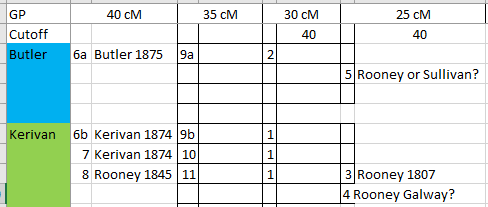
Cluster 6 – A Butler Cluster
This is an interesting Cluster because it includes a Cincinnati branch of Butlers who are related to Suzy’s Butlers, but we don’t know how yet. Here is my guess how they could match:

The George Butler Branch from Cincinnati is on the left. The Edward Butler branch who lived for a while in Cincinnati ended up in the Boston area.
Within Cluster 6 is the Boston group and the Cincinnati group:

The last two matches that I don’t have a green box around are closer Butler relatives.
Cluster 7 – Back to the Kerivan Side

I don’t see any new matches in this group, so no new news.
Clusters 8-12
These are all new clusters:

I don’t know if these are Irish or French Canadian Clusters.
On to the Final Clustering at 20 cM
In this run, I’ll choose 6 cM and have a maximum cluster size of 40 keeping in mind that Ancestry’s shared matches are generally at the 20 cM size or larger. This gives me 20 Clusters and some greater detail on what I had already.
First I’ll pull this new information into Access to see how the Clusters map:

This cut off a few clusters at the top. First I see in the 7th row from the bottom, Cluster 2 that went to 1 has no cluster in the last row. That was the cluster that I was wary of.
Here is a sort by the previous run of Clusters:

This tells me the new Cluster 1 is from the previous Cluster 2. The new Cluster 2 had no precedent. One large tree in Cluster 2 had a Crowley ancestor from Cork, but that may be a coincidence.
Cluster Three maps to previous Cluster 9 which I haven’t looked at. I see another Gilmarting in Cluster 3. His ancestry goes back to Leitrim, Ireland. After clicking through a lot of connections, I would guess that the connection is through Ireland. Also a lot of the connections are in Leitrim and I found one tree with a Rooney in it from Leitrim:

Here is an interesting match between Clusters 3 and 4:

This wants to tie together the Jeremiah and John Rooney Lines.
ThruLines suggests another Rooney Line:

Skipping Down to the Butler Clusters
The new Cluster 11 mapped to the previous Cluster 6:

There is nothing new in Cluster 11 itself, but the interesting part is outside Cluster 11 proper:

However, there are four matches above Cluster 11 that show association with Cluster 11. The first person is managed by Patty who I already know about:

Patty is on the George Butler Line. George Butler came to live in Cincinnati.
The third person in the group of matches that are correlated to Cluster 11 is Regina. Here is her tree:

I recognize the Branch name above. Here is the marriage record for Alma from 1925:

Another person in the group that is correlated with Cluster 11 is Ryan. Here is his tree:

Both of Ryan’s parents were born in Cincinnati. I need to build yet another tree to see if I can find a match:

With a little snooping around, I was able to get back to Alma Branch:

Christy is on the other side of the Cluster 11:

She fits in on the Boston George side:

Emily married an unrelated Butler.
Next under Christy is Larry:

Larry matches clusters on either side. Here is here small tree:

The tree is interesting as both parents are from Wexford. Some of the Butler ancestors were also from Wexford. Unfortunately, the tree is a bit confusing to follow. Was Bridget’s maiden name Browne or Hesse?
Larry has shared matches with Suzy, Brian, Barbara and Janice:

That seems to make Larry a sort of missing link.
Summary and Conclusions
- I did a first shot at looking at Suzy’s Shared Clusters
- Not too far into looking at Suzy’s clusters, her French Canadian Clusters got very large.
- I restricted the size of Suzy’s clusters so I could look more at her smaller clusters on her Irish side.
- This lead me to some interesting finds on her Kerivan and Butler side.
- One Butler match was very interesting as it was shared with two Butler branches that I have been trying to connect.















































































































































































































































